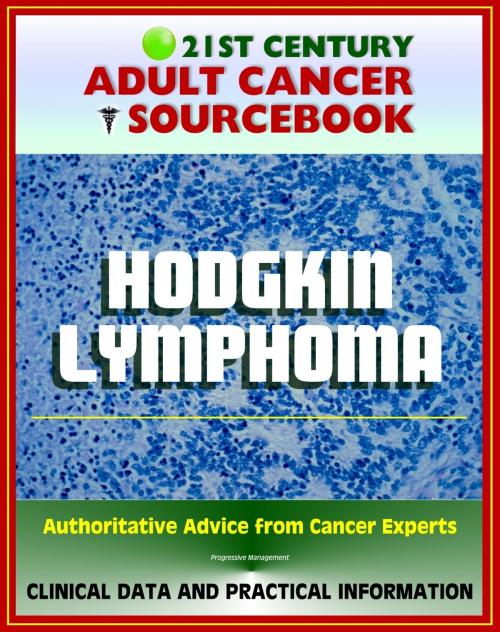21st Century Adult Cancer Sourcebook: Hodgkin Lymphoma (HL) - Clinical Data for Patients, Families, and Physicians
Nonfiction, Health & Well Being, Health, Ailments & Diseases, Cancer| Author: | Progressive Management | ISBN: | 9781465924988 |
| Publisher: | Progressive Management | Publication: | October 11, 2011 |
| Imprint: | Smashwords Edition | Language: | English |
| Author: | Progressive Management |
| ISBN: | 9781465924988 |
| Publisher: | Progressive Management |
| Publication: | October 11, 2011 |
| Imprint: | Smashwords Edition |
| Language: | English |
Authoritative information and practical advice from the nation's cancer experts about hodgkin lymphoma (HL) includes official medical data on signs, symptoms, early detection, diagnostic testing, risk factors and prevention, treatment options, surgery, radiation, drugs, chemotherapy, staging, biology, prognosis, and survival, with a complete glossary of technical medical terms and current references.
Starting with the basics, and advancing to detailed patient-oriented and physician-quality information, this comprehensive in-depth compilation gives empowered patients, families, caregivers, nurses, and physicians the knowledge they need to understand the diagnosis and treatment of HL.
Comprehensive data on clinical trials related to HL is included - - with information on intervention, sponsor, gender, age group, trial phase, number of enrolled patients, funding source, study type, study design, NCT identification number and other IDs, first received date, start date, completion date, primary completion date, last updated date, last verified date, associated acronym, and outcome measures.
Adult Hodgkin lymphoma is a type of cancer that develops in the lymph system, part of the body's immune system. The lymph system is made up of the following:
* Lymph: Colorless, watery fluid that travels through the lymph system and carries white blood cells called lymphocytes. Lymphocytes protect the body against infections and the growth of tumors.
* Lymph vessels: A network of thin tubes that collect lymph from different parts of the body and return it to the bloodstream.
* Lymph nodes: Small, bean-shaped structures that filter lymph and store white blood cells that help fight infection and disease. Lymph nodes are located along the network of lymph vessels found throughout the body. Clusters of lymph nodes are found in the underarm, pelvis, neck, abdomen, and groin.
* Spleen: An organ that makes lymphocytes, filters the blood, stores blood cells, and destroys old blood cells. It is located on the left side of the abdomen near the stomach.
* Thymus: An organ in which lymphocytes grow and multiply. The thymus is in the chest behind the breastbone.
* Tonsils: Two small masses of lymph tissue at the back of the throat. The tonsils produce lymphocytes.
* Bone marrow: The soft, spongy tissue in the center of large bones. Bone marrow produces white blood cells, red blood cells, and platelets.
Because lymph tissue is found throughout the body, Hodgkin lymphoma can begin in almost any part of the body and spread to almost any tissue or organ in the body. Lymphomas are divided into two general types: Hodgkin lymphoma and non-Hodgkin lymphoma. Hodgkin lymphoma can occur in both adults and children; however, treatment for adults may be different than treatment for children. Hodgkin lymphoma may also occur in patients who have acquired immunodeficiency syndrome (AIDS); these patients require special treatment.
Extensive supplements, with chapters gathered from our Cancer Toolkit series and other reports, cover a broad range of cancer topics useful to cancer patients. This edition includes our exclusive Guide to Leading Medical Websites with updated links to 81 of the best sites for medical information, which let you quickly check for updates from the government and the best commercial portals, news sites, reference/textbook/non-commercial portals, and health organizations. Supplemental coverage includes:
Levels of Evidence for Cancer Treatment Studies
Glossary of Clinical Trial Terms
Clinical Trials Background Information and In-Depth Program
Clinical Trials at NIH
How To Find A Cancer Treatment Trial: A Ten-Step Guide
Taking Part in Cancer Treatment Research Studies
Access to Investigational Drugs
Authoritative information and practical advice from the nation's cancer experts about hodgkin lymphoma (HL) includes official medical data on signs, symptoms, early detection, diagnostic testing, risk factors and prevention, treatment options, surgery, radiation, drugs, chemotherapy, staging, biology, prognosis, and survival, with a complete glossary of technical medical terms and current references.
Starting with the basics, and advancing to detailed patient-oriented and physician-quality information, this comprehensive in-depth compilation gives empowered patients, families, caregivers, nurses, and physicians the knowledge they need to understand the diagnosis and treatment of HL.
Comprehensive data on clinical trials related to HL is included - - with information on intervention, sponsor, gender, age group, trial phase, number of enrolled patients, funding source, study type, study design, NCT identification number and other IDs, first received date, start date, completion date, primary completion date, last updated date, last verified date, associated acronym, and outcome measures.
Adult Hodgkin lymphoma is a type of cancer that develops in the lymph system, part of the body's immune system. The lymph system is made up of the following:
* Lymph: Colorless, watery fluid that travels through the lymph system and carries white blood cells called lymphocytes. Lymphocytes protect the body against infections and the growth of tumors.
* Lymph vessels: A network of thin tubes that collect lymph from different parts of the body and return it to the bloodstream.
* Lymph nodes: Small, bean-shaped structures that filter lymph and store white blood cells that help fight infection and disease. Lymph nodes are located along the network of lymph vessels found throughout the body. Clusters of lymph nodes are found in the underarm, pelvis, neck, abdomen, and groin.
* Spleen: An organ that makes lymphocytes, filters the blood, stores blood cells, and destroys old blood cells. It is located on the left side of the abdomen near the stomach.
* Thymus: An organ in which lymphocytes grow and multiply. The thymus is in the chest behind the breastbone.
* Tonsils: Two small masses of lymph tissue at the back of the throat. The tonsils produce lymphocytes.
* Bone marrow: The soft, spongy tissue in the center of large bones. Bone marrow produces white blood cells, red blood cells, and platelets.
Because lymph tissue is found throughout the body, Hodgkin lymphoma can begin in almost any part of the body and spread to almost any tissue or organ in the body. Lymphomas are divided into two general types: Hodgkin lymphoma and non-Hodgkin lymphoma. Hodgkin lymphoma can occur in both adults and children; however, treatment for adults may be different than treatment for children. Hodgkin lymphoma may also occur in patients who have acquired immunodeficiency syndrome (AIDS); these patients require special treatment.
Extensive supplements, with chapters gathered from our Cancer Toolkit series and other reports, cover a broad range of cancer topics useful to cancer patients. This edition includes our exclusive Guide to Leading Medical Websites with updated links to 81 of the best sites for medical information, which let you quickly check for updates from the government and the best commercial portals, news sites, reference/textbook/non-commercial portals, and health organizations. Supplemental coverage includes:
Levels of Evidence for Cancer Treatment Studies
Glossary of Clinical Trial Terms
Clinical Trials Background Information and In-Depth Program
Clinical Trials at NIH
How To Find A Cancer Treatment Trial: A Ten-Step Guide
Taking Part in Cancer Treatment Research Studies
Access to Investigational Drugs















